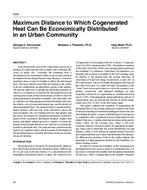Description
At the present time, most of the United States electricity is produced in large thermal power plants with a thermal efficiency of about 30%. Generally, the remaining heat is discharged to the environment. While it may be uneconomical to transport the discharged heat for large distances, in densely populated areas, it may be feasible to utilize this discharged heat. This heat could be used either for heating in the winter or for air conditioning, via absorption cooling, in the summer. The present study tries to identify the distribution distance to which it is economical to transmit the discharged heat of an existing power plant, in the form of steam, in order to meet the heating demand of an urban community. The study takes into account the cost of the piping network for distribution of steam, the relative costs of steam and natural gas, and the density of urban demand for heat. The variation of the economical distribution distance with each one of the parameters above has been calculated. The cost of piping network, heat density, and fuel prices are found to be significant parameters in determination of the economical distribution distance. Higher heat density and higher natural gas prices (relative to steam) are found to lead to longer distances over which it is economically feasible to distribute heat. The study provides a framework for analysis of conditions under which economical distribution of the discharged heat is a feasible alternative to the use of natural gas for heating.
Units: Dual
Citation: ASHRAE Transactions, vol. 108, pt. 1, Atlantic City, 2002
Product Details
- Published:
- 2002
- Number of Pages:
- 6
- File Size:
- 1 file , 340 KB
- Product Code(s):
- D-6970




